Imaging and percutaneous treatment of vascular anomalies
- PMID: 21326512
- PMCID: PMC3036444
- DOI: 10.1055/s-0028-1085921
Imaging and percutaneous treatment of vascular anomalies
Abstract
Vascular anomalies are an extensive group of malformations of the arterial, venous, and lymphatic systems, either in isolation or, more often, in combination. Although mostly congenital, they can occasionally be acquired as well. They present a challenge both for workup and therapy. This article attempts to describe some of their main anomalies, their workup, and their therapies, with the goal of increasing the comfort level of endovascular therapists.
Keywords: Vascular anomalies; embolization; hemangiomas; malformations; percutaneous endovascular therapy.
Figures
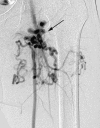
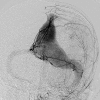

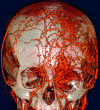
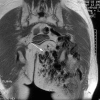

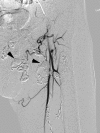
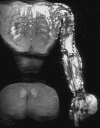

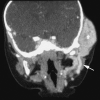


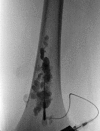






Similar articles
-
Peripheral Vascular Anomalies - Essentials in Periinterventional Imaging.Rofo. 2020 Feb;192(2):150-162. doi: 10.1055/a-0998-4300. Epub 2019 Oct 17. Rofo. 2020. PMID: 31622988 English.
-
[Interdisciplinary concept for classification and treatment of vascular anomalies in the head and neck].Mund Kiefer Gesichtschir. 2002 Nov;6(6):402-9. doi: 10.1007/s10006-002-0418-z. Epub 2002 Aug 9. Mund Kiefer Gesichtschir. 2002. PMID: 12447652 German.
-
Congenital vascular malformations: when and how to treat them.Semin Vasc Surg. 2002 Mar;15(1):65-71. doi: 10.1053/svas.2002.30450. Semin Vasc Surg. 2002. PMID: 11840428 Review.
-
[Extracranial vascular anomalies (hemangiomas and vascular malformations) in children and adolescents--diagnosis, clinic, and therapy].Laryngorhinootologie. 2014 Mar;93 Suppl 1:S185-202. doi: 10.1055/s-0033-1363216. Epub 2014 Apr 7. Laryngorhinootologie. 2014. PMID: 24710783 Review. German.
-
Endovascular methods for the treatment of vascular anomalies.Neuroimaging Clin N Am. 2013 Nov;23(4):703-28. doi: 10.1016/j.nic.2013.03.016. Epub 2013 May 30. Neuroimaging Clin N Am. 2013. PMID: 24156860 Review.
Cited by
-
Endovascular balloon-assisted liquid embolisation of soft tissue vascular malformations: technical feasibility and safety.CVIR Endovasc. 2021 Jun 8;4(1):49. doi: 10.1186/s42155-021-00236-4. CVIR Endovasc. 2021. PMID: 34101056 Free PMC article.
-
Pediatric Vascular Anomalies: A Clinical and Radiological Perspective.Indian J Radiol Imaging. 2023 Sep 16;34(1):103-127. doi: 10.1055/s-0043-1774391. eCollection 2024 Jan. Indian J Radiol Imaging. 2023. PMID: 38106867 Free PMC article. Review.
-
A Step-by-Step Practical Approach to Imaging Diagnosis and Interventional Radiologic Therapy in Vascular Malformations.Semin Intervent Radiol. 2010 Jun;27(2):209-31. doi: 10.1055/s-0030-1253521. Semin Intervent Radiol. 2010. PMID: 21629410 Free PMC article.
References
-
- Mulliken J B, Glowacki J. Hemangiomas and vascular malformations in infants and children: a classification based on endothelial characteristics. Plast Reconstr Surg. 1982;69(3):412–422. - PubMed
-
- JK W, TS L, CT R, et al. For hemangiomas refractory to first line corticosteroid therapy, interferon and vincristine therapy has been described. Wellington, New Zealand: 2004. In, International Society for the Study of Vascular Anomalies.
-
- Chang M W. Updated classification of hemangiomas and other vascular anomalies. Lymphat Res Biol. 2003;1(4):259–265. - PubMed
-
- Upton J, Coombs C J, Mulliken J B, Burrows P E, Pap S. Vascular malformations of the upper limb: a review of 270 patients. J Hand Surg [Am] 1999;24(5):1019–1035. - PubMed
-
- Cho S K, Do Y S, Shin S W, Kim D I, et al. Arteriovenous malformations of the body and extremities: analysis of therapeutic outcomes and approaches according to a modified angiographic classification. J Endovasc Ther. 2006;13:527–538. - PubMed

